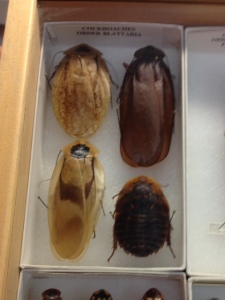More than just Pests
February 16, 2013
Cockroaches and termites belong to the order Blattodea. Several cockroach species are identified as pests, but most cockroaches are relatively harmless. A recent change now indicates termites as a part of Blattodea, since previously they were considered part of Isoptera (more information here).
Cockroaches have a wide range of diversity, and currently about 4,500 species have been named (Beccaloni). Most cockroach species are found in tropical and subtropical climates, however, some species do live in temperate climates—these would be the species most closely associated to those considered pests or vermin (Meyer).
Basic Anatomy & Exoskeleton
Many cockroach species do not have wings, or if they do they are reduced. The nymph stage of a cockroach has similar physical attributes when compared to an adult cockroach. Adult cockroaches have long antennae and legs, which have been identified as being adapted for moving quickly along surfaces or running (Meyer).
Cockroaches also have a “pronotum oval” that covers a large portion of the body and looks similar to a shield (Meyer). The cuticle of the cockroaches made of plates, which are known as scerlites. These include: one dorsal plate, one ventral plate and two lateral plates. (Cockroach Exoskeleton). Bristles and spines protrude on the outside of the cuticle.
Reproduction
Adult roaches reproduce sexually, mating facing away from each other. They use pheromones to attract mates and some males practice courtship rituals; as with other insects, mating can take a long time (Wilson). Cockroach young are called nymphs, and besides having underdeveloped wings and genitalia, they closely resemble adults; they undergo gradual or ‘incomplete’ metamorphosis, as opposed to insects with larval stages–such as caterpillars which molt into butterflies (Iowa State University Entymology). Their development is comparatively slow; depending on the species, it may take anywhere from one month to one year for all the molts between hatching and adulthood
Humans & Cockroach Behavior
Some people react vigorously by screaming at the sight of a cockroach. While most are considered pests, only about 30 of the 4,500 identified species cause any disturbance to people. However, humans should be cautious of the pathogens cockroaches carry on their bodies—those pathogens, not the cockroach, can trigger health conditions such as asthma, infection, and food poisoning.
The elusive cockroaches will most likely scamper away and conceal themselves before one can take any further action (e.g. step on the roach). Since cockroaches detest sunlight and artificial lighting, they tend to hide in places such as the narrow crevices of a wall which can best shield them from the light. Thus, cockroaches are often considered nocturnal because it is rare to spot them during the day. They embark on a new adventure every night and forage all over for nourishment and water.
Besides consuming foods that humans may find inedible such as decomposing fruits and vegetables, cockroaches feed on sweets, proteins, and starches. These delectable staples can all be found in a kitchen. Therefore, cockroaches will seek shelter indoors despite their natural habitat being outdoors. Cockroaches are not only notorious for their remarkable ability to travel at rapid speed, but also for being prolific breeders. Certain domestic cockroach species are considered pests because they can produce a plethora of offspring and infest the kitchen.
Cockroaches have a resiliency that is both admirable and scary. It is rumored that cockroaches can live without their heads for weeks. But fear not, the rumor is true. Headless cockroaches can in fact scurry about for a few days or weeks without a head. “How?” You ask. It’s quite creepy to think about actually.
The reasons humans cannot survive decapitation are loss of blood and a drop in blood pressure that prevents oxygen and nutrition from reaching vital tissues, or the brain can no longer control breathing. If the body somehow survives these reasons of death, the body still lacks a way of eating and will die of starvation. (Choi)
The reasons cockroaches can survive decapitation are they are able to breathe through little holes in each body segment called spiracles that is not controlled by the brain, the neck of the cockroach would also seal off due to blood clotting that prevents it from bleeding out, and cockroaches are cold-blooded, which means they can survive on much less food than humans do, relative to their own body sizes, of course.
It’s one thing to be a pest, but it’s a whole different situation to be a pest that refuses to die. So if you want to kill a cockroach just step on it. Don’t take the time to pull off its head and allow it to harass you further in the kitchen.
Reference
http://www.cals.ncsu.edu/course/ent425/library/compendium/isoptera.html
http://blattodea.speciesfile.org/HomePage/Blattodea/HomePage.aspx
http://www.cals.ncsu.edu/course/ent425/library/compendium/blattodea.html#physical
http://www.transtutors.com/biology-homework-help/cockroach/exoskeleton/
http://science.howstuffworks.com/zoology/insects-arachnids/cockroach2.htm
http://bugguide.net/node/view/342386#life_cycle
http://www.scientificamerican.com/article.cfm?id=fact-or-fiction-cockroach-can-live-without-head



